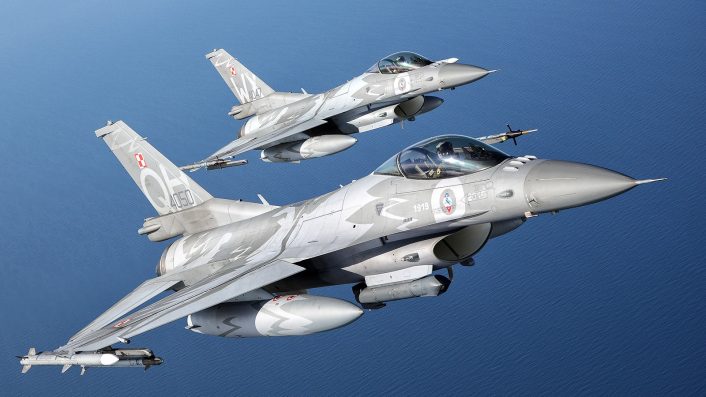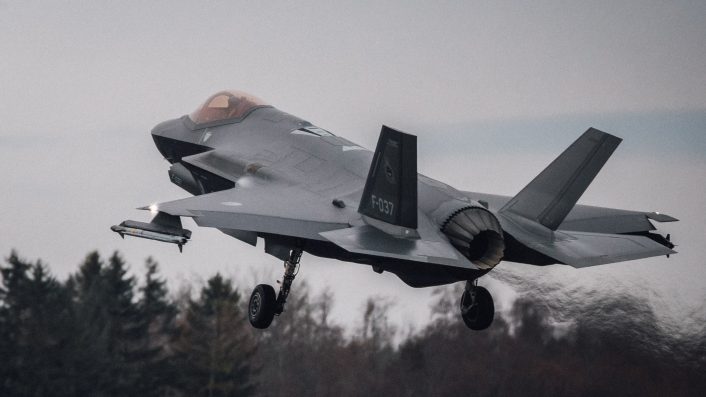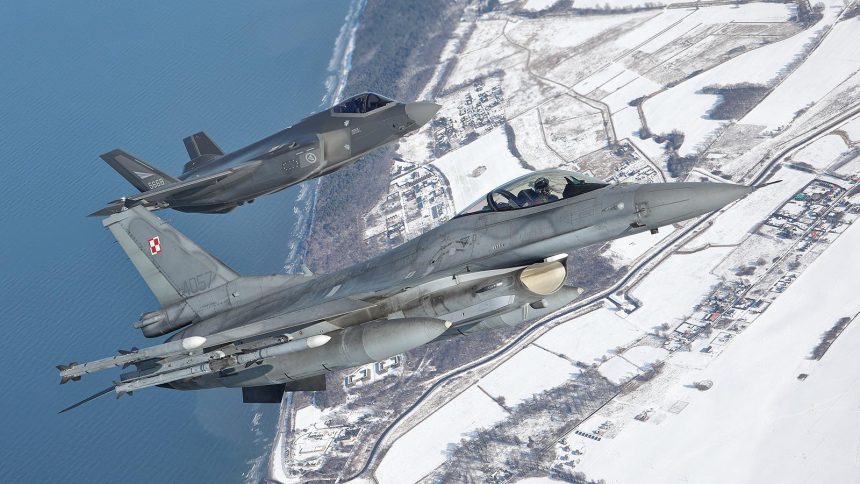Warsaw confirms Russian drones violated its airspace overnight, marking the first direct engagement of Russian assets over NATO territory.
Poland has confirmed it shot down multiple Russian drones that violated its airspace in the night between Sep. 9 and 10, 2025, during Moscow’s latest large-scale strike on Ukraine. The unprecedented incident marks the first time that Russian assets have been destroyed over NATO territory since the start of Russia’s full-scale invasion of Ukraine in 2022.
According to Polish Prime Minister Donald Tusk, a “huge number” of Russian drones crossed into Polish skies during the assault, which targeted several Ukrainian regions. Speaking ahead of an emergency government meeting in Warsaw, Tusk described the incursions as “a large-scale provocation” and emphasized that “all our allies are taking the situation very seriously.”
Russia’s drone and missile attack on Ukraine and Poland tonight, from Ukrainian monitors. pic.twitter.com/EwjapRBd8M
— OSINTtechnical (@Osinttechnical) September 10, 2025
He added that the drones posing an immediate threat were neutralized by fighter jets, with no casualties reported. NATO forces were also involved, including the Royal Netherlands Air Force’s F-35s currently deployed to Poznan Krzesiny airbase for NATO’s Air Policing mission.
Nad Polską trwa operacja neutralizacji obiektów, które naruszyły granicę RP. Prezydent i Premier zostali powiadomieni. Wszystkie służby działają. Prosimy o stosowanie się do komunikatów Wojska Polskiego i Policji. Samoloty użyły uzbrojenia przeciwko wrogim obiektom. Jesteśmy w…
— Władysław Kosiniak-Kamysz (@KosiniakKamysz) September 10, 2025
The Overnight Operation
Poland’s Armed Forces Operational Command confirmed that its airspace was “repeatedly violated by drone-type objects” during Russia’s coordinated strike, which involved hundreds of drones and missiles across Ukraine. In response, Polish and allied fighter jets were scrambled while ground-based air defense and radar systems were placed on the highest state of readiness.
Doczekaliśmy się momentu w którym Polak może w swoim ogrodzie znaleźć resztki naszego albo holenderskiego pocisku powietrze – powietrze AIM-120 C-7 AMRAAM którym strzelano do rosyjskich dronów.
Gwoli jasności, tonie jest powód do radości
— Dawid Kamizela (@DawidKamizela) September 10, 2025
At its height, the operation involved both Polish aircraft and NATO assets, including Dutch F-35s and German Patriot units deployed in Poland. Notably, a Polish Saab 340 AEW&C (Airborne Early Warning and Control) aircraft was spotted in flight for nine hours to support the defenses. A NATO MMF A-330 MRTT was also orbiting in the area.
After a major 9+ hour mission hunting Russian drones and coordinating air defenses overnight, Poland’s SAAB 340 airborne early warning aircraft is heading for home. pic.twitter.com/L1McAqVWz1
— OSINTtechnical (@Osinttechnical) September 10, 2025
1x Polish AEW&C aircraft over Poland currently monitoring the eastern border.
Additionally, 1x NATO refueling aircraft was over Polish airspace supporting fighter jets, including at least one F-35, in the task of neutralizing Russian drones that have crossed the Polish border. pic.twitter.com/Dek3DwGFLb
— Amelia Smith (@ameliairheart) September 10, 2025
Tusk confirmed that “two F-35s, two F-16s, and Mi-24, Mi-17 and Black Hawk helicopters were dispatched to the anticipated area of operations.” As already mentioned, the F-35s belonged to the RNLAF, while the F-16s are from the Polish Air Force.
💬 Premier @DonaldTusk w #SejmRP: Do przewidywanego rejonu działania skierowano dwa F-35, dwa F-16 oraz śmigłowce MI-24, MI-17 i Black Hawk. Pierwsze naruszenie przestrzeni powietrznej odnotowano około 23:30, ostatnie o 6:30, co pokazuje skalę operacji trwającej całą noc.…
— Kancelaria Premiera (@PremierRP) September 10, 2025
An Italian E-550A CAEW (Conformal Airborne Early Warning) was spotted on flight tracking websites while flying towards the area, although it is unclear if the events are related, as the aircraft often fly in the area for NATO’s surveillance operations. According to Reuters, however, citing NATO sources, the Italian aircraft was indeed involved in the operation.
Social media posts claim that U.S., Italian and Dutch F-35s were deployed to support Poland, but its is not possible to verify this information. In fact, only the Dutch F-35s’ participation has been officially confirmed.
Dutch F-35s have intercepted Russian drones over Poland.
Within the NATO framework, our F-35s make a significant contribution to the defence of our collective security. This is precisely what we stand ready to do.
This is how we keep the escalating Russian threat at a distance. pic.twitter.com/fxZDbAXuTG
— Ruben Brekelmans (@DefensieMin) September 10, 2025
The claim might have been originated by the presence on flight tracking websites of a U.S. F-35 with Mode-S hex code AF351F, however that is a generic code used by all F-35 operators. As for the Italian F-35s, they are currently deployed in Estonia for Baltic Air Policing and unlikely to have been involved.
30 minutes on, still hasn’t reappeared.
🇮🇹 PERSE71 is C-37B MM62293 #33FDC2 https://t.co/CcrXhW5nN3 pic.twitter.com/TAcqZ1xSDV
— Evergreen Intel (@vcdgf555) September 10, 2025
Airports across Poland were temporarily closed, including Warsaw’s Chopin and Modlin airports, as well as Rzeszów-Jasionka — a major logistics hub for military aid to Ukraine — and Lublin Airport. The Polish government sent emergency SMS alerts to citizens in the eastern regions of Lublin, Podlaskie, and Mazowieckie, urging residents to shelter and report any drone wreckage to authorities.
By morning, the Polish military confirmed the immediate operation had ended, and civilian air traffic gradually resumed. Authorities also reported locating debris from downed drones in several villages, including Czosnówka and Cześniki in eastern Poland, and later near Mniszków in the Łódź region.

Scale of Russia’s Attack
Ukraine’s Air Force reported that Russia launched one of its largest aerial assaults in months, deploying 415 drones, 42 cruise missiles, and a ballistic missile overnight. Ukrainian defenses intercepted most of the incoming threats, but at least eight Shahed-type drones crossed into Poland’s direction, some penetrating Polish airspace.
A Russian Gerbera attack drone penetrated nearly 300 km of Polish airspace and was found in the Polish town of Mniszków, per RMF 24. pic.twitter.com/6veUFznOhJ
— OSINTtechnical (@Osinttechnical) September 10, 2025
Ukrainian President Volodymyr Zelensky described the incursion as “an extremely dangerous precedent for Europe,” warning that Moscow was “pushing the boundaries of what is possible” in its aggression. He called for a stronger international response and tighter sanctions on Russia, adding: “It was not just one Shahed that could be called an accident, but at least eight attack drones aimed toward Poland.”
Another report from the Commander of our Air Force. We are clarifying all available data and analyzing the details of this Russian strike.
Already during the night, Ukrainian forces were informing the Polish side through the relevant channels about the movement of Russian…
— Volodymyr Zelenskyy / Володимир Зеленський (@ZelenskyyUa) September 10, 2025
The number of drones intruding into Poland’s airspace is not yet final. Currently, reports mention that the number of drones might have been between 5 and over 20, with photos showing the debris of at least three different drones. Tusk said 19 violations were recorded between 11:30 pm and 06:30 am, local time, and data is still being updated.
Gerbera znaleziona w Czosnówce pod Białą Podlaska.
Ewidentny brak paliwa w dronie – wabiu. Widoczne regi na stateczniku pionowym.
Dziękuję Widzowi za podesłanie. https://t.co/k2OmwebfIr pic.twitter.com/ZVyYccjWjT
— Jarosław Wolski (@wolski_jaros) September 10, 2025
Political and Military Reactions
Polish officials stressed that their response had been swift and coordinated. Defense Minister Władysław Kosiniak-Kamysz confirmed that Poland was in constant contact with NATO Command, while Territorial Defense Force units were mobilized to assist in the ground search for drone wreckage. President Karol Nawrocki, who leads Poland’s National Security Bureau, stated that the “security of our homeland is our highest priority.”
Last night the Polish airspace was violated by a huge number of Russian drones. Those drones that posed a direct threat were shot down. I am in constant communication with the Secretary General of NATO and our allies.
— Donald Tusk (@donaldtusk) September 10, 2025
Numerous drones entered Polish airspace overnight and were met with Polish and NATO air defences. @SecGenNATO is in touch with Polish leadership and @NATO is consulting closely with Poland 🇵🇱
— NATO Spokesperson (@NATOpress) September 10, 2025
According to Reuters, NATO is not treating the incident as an attack but as an intentional incursion. The European Union’s top diplomat Kaja Kallas imilarly said the incursion was intentional and not accidental.
Across Europe, the incursion drew swift condemnation. Swedish Prime Minister Ulf Kristersson called the violation “unacceptable,” affirming that “Poland has every right to defend its airspace.” Latvia, Norway, and Lithuania issued similar statements of solidarity, with Lithuania’s Foreign Minister Kestutis Budrys warning that NATO must “respond with force, not just concern.”
European Council President Antonio Costa also expressed support, describing the incident as an “unacceptable violation” of Polish sovereignty. In the United States, lawmakers reacted strongly, noting the seriousness of Russian aerial assets over NATO territory and even calling it “an act of war.”

Escalation and Implications
The shootdown represents a significant escalation for Poland, which until now had scrambled jets and monitored Russian activity near its border but had never directly engaged drones or missiles. The incident recalls earlier border tensions, such as the 2022 missile strike that killed two Polish civilians in Przewodów, later attributed to a misfired Ukrainian air defense interceptor. Unlike that event, this time Warsaw explicitly blamed and targeted Russian-origin drones.
Poland has been one of NATO’s most outspoken members on the Russian threat, significantly increasing defense spending and acquiring new fighter jets, tanks, and missile systems. The overnight engagement is likely to reinforce calls in Warsaw for even closer allied cooperation and stronger deterrence measures on NATO’s eastern flank.
The incursion highlights the risks faced by Ukraine’s neighboring countries as Russia escalates aerial attacks. Kyiv has repeatedly called for NATO allies to extend air defense coverage into western Ukraine to prevent drones and missiles from reaching NATO borders. Ukrainian Foreign Minister Andriy Sybiha now renewed this appeal, arguing that it is “necessary to enable the use of partner air defense capabilities in neighboring countries” to intercept threats before they cross into allied territory, according to Polish outlet PolsatNews.
A Turning Point for NATO?
While no injuries were reported in Poland, despite a house being damaged by debris, the danger demonstrated by the event is substantial. In fact, it demonstrated that Russian weapons used in Ukraine can penetrate NATO skies, forcing the alliance to act militarily, even if defensively, on its own soil.
A Russian attack drone hit and damaged a house in the village of Wyryki, Poland, overnight. pic.twitter.com/kWFmZ0iawz
— OSINTtechnical (@Osinttechnical) September 10, 2025
This can also be viewed as a further confirmation of the need for the renewed focus on integrated air defenses to stop current and emerging threats, such as the one-way attack drones. Poland, which is currently involved in a heavy modernization of its armed forces, says it is satisfied with its response to tonight’s threat.
Prime Minister Tusk sought to reassure the public after the emergency meetings, declaring: “This first test — our military, our allies, and the procedures prepared for such an eventuality — has been passed. The situation is under control, and there is no reason to panic.”
What comes next may depend on how NATO collectively chooses to respond to what Poland’s government has already described as “an unprecedented violation of Polish airspace.” Poland is now evaluating how to respond, with unconfirmed reports about invoking NATO’s Article 4 for emergency discussions about the recent events.
The article states:
“The Parties will consult together whenever, in the opinion of any of them, the territorial integrity, political independence or security of any of the Parties is threatened.”
The last time the article was invoked was in 2022, when Bulgaria, Czechia, Estonia, Latvia, Lithuania, Poland, Romania and Slovakia requested to hold consultations under Article 4 following Russia’s full-scale invasion of Ukraine. Since the Alliance’s creation in 1949, Article 4 has been invoked seven times.









